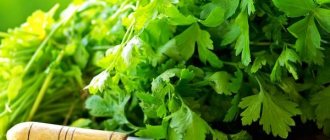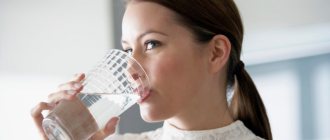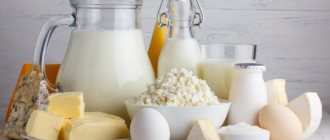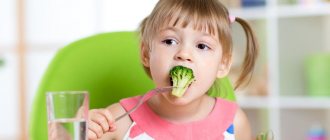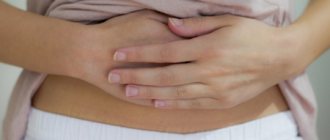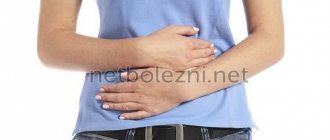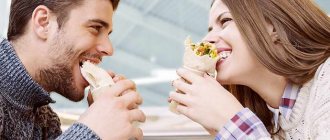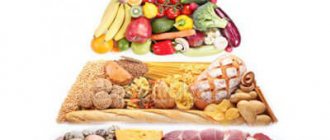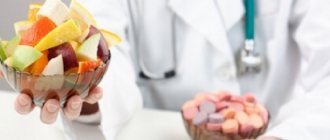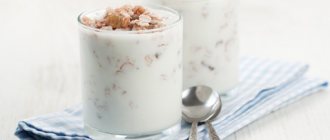Abnormal bowel movements, rumbling intestines, bloating, nausea, vomiting - all these are common symptoms of gastrointestinal disorders that everyone has experienced in their lives. Simultaneous inflammation of the large and small intestines is a clear sign of enterocolitis, with symptoms reminiscent of gastritis.
It is not easy to determine the cause of the disease without medical help, and the disease must be recognized urgently so that complications do not arise. The complex of treatment procedures includes a diet for enterocolitis.
To confirm the diagnosis, laboratory microscopic tests of stool, culture, X-ray examination of the intestines, general blood test, biochemistry, additional instrumental examination, etc. are usually performed.
Five reasons that provoke enterocolitis
- Bacteria and viruses. Many infectious pathogens exhibit affinity for the gastrointestinal mucosa, which provokes inflammation (Shigella, Salmonella, enteropathogenic E. coli, and others).
- Parasites. A whole group of protozoa and helminths can become inhabitants of the intestines, causing enterocolitis.
- Toxins and poisons. Many substances can cause intestinal damage (high concentrations of alcohol, benzene, acetic acid, etc.).
- Allergens. Due to increased individual sensitivity, an allergic reaction in the intestinal wall may develop.
- Nutritional features. Certain foods can cause damage to the sensitive epithelium of the small and large intestines.
It should be noted that not everyone develops enterocolitis, since certain conditions must be created:
- decrease in general immunity (IgA concentration, number of macrophages and other protective factors);
- genetic predisposition (more often in women);
- concomitant gastrointestinal diseases (for example, atrophic gastritis).
Depending on the type of damage, various forms of enterocolitis may occur: catarrhal, ulcerative, ulcerative-necrotic and others.
Often, such a disease develops along with acute gastritis and develops due to the fact that a person eats low-quality foods, which, most likely, were contaminated with substances from natural bacteria, also if you eat a lot of fatty foods, spicy or rough (constant dryness) .
Fruits or vegetables that are not yet ripe can also become one of the causes of the disease. In addition, enterocolitis accompanies a number of other diseases that are associated with the intestines.
Types of enterocolitis
Infectious enterocolitis is conventionally divided into 2 groups:
- parasitic - caused by the effect of worms, trichomonas, amoebic dysentery on the mucous membrane;
- bacterial - caused by the influence of a large number of infections created by several types of pathogens: from salmonella, staphylococcus, to dysentery bacillus.
The following group of factors for the occurrence of enterocolitis is non-infectious in nature, namely:
- Long-term use of medications, incl. antibiotics without a doctor's prescription. Such self-medication provokes dysbiosis, promotes the destruction of mucous membranes, and weakens the immune system.
- Frequent contact with chemicals or poisons in hazardous industries.
- Irrational and unbalanced nutrition - uncontrolled intake of excessively fatty, spicy and salty foods, consumption of unsuitable foods, violation of diet.
- The occurrence of intestinal obstruction, accompanied by constipation, scarring, and the formation of tumors.
- Allergic reactions provoked by individual intolerance to any food product.
- Infection of the body with intestinal viruses, pathogens, parasites, bacteria, etc.
- Weakened immunity.
- Abdominal injuries, etc.
All of the above factors affect the body, regardless of age category.
Indicators of the development of enterocolitis:
- mechanical – dependent on constipation, intestinal stenosis, intestinal obstruction, cystic tumor;
- toxic - provoked by long-term influence on the body of poisons, abuse of alcohol, nicotine, drugs, medications;
- nutritional – in older people it is caused by the abuse of spicy, fried, salty foods; children suffer due to improper intake of additional nutrition, violation of the regime, and hygiene rules while eating;
- allergic – occurs in people with individual intolerance, accompanied by asthma, fever, changes in the skin;
- secondary – a combination of exacerbations aggravated by other infections;
- bacterial – the result of the penetration of a number of viral bacteria into the body;
- parasitic – caused by the colonization of viruses and parasites in the intestines, provoking inflammatory processes in the gastrointestinal tract.
It is important to remember that the following types of complications may develop during illness:
- Ulcerative – abscesses and bleeding wounds form on the intestinal mucosa.
- Necrotic - the course of the disease is complicated by the death of intestinal fragments, which can be fatal.
If symptoms of acute enterocolitis are detected, immediate hospitalization is required in the gastroenterology department or infectious diseases hospital. Due to severe dehydration, the patient is given hydration therapy, i.e. replacement of the body with fluid lost during the disease. To do this, medicinal solutions are administered intravenously, the stomach is washed, and the intestines are cleansed.
Chemical composition of diet No. 4a:
- proteins up to 100 g (60-70% animal origin, 30-40% plant origin);
- fats 70 g (50-60% vegetable, 40-50% animal origin);
- carbohydrates 250 g (no more than 45 g sugar);
- salt 10 g;
- liquid 1.5-2 l.
Weight of daily ration: 2.5-3 kg. Daily intake of diet No. 4: 2000-2050 kcal. Diet: 5-6 times a day.
- proteins 120 g;
- fats 50 g;
- carbohydrates 140 g;
- salt 6 g;
- liquid up to 1.5 l.
Daily intake of diet No. 4a: 1600 kcal. Diet: 5 times a day.
Traditional methods of treating enterocolitis
Acute enterocolitis affects only the upper layers of the mucosa. Chronic occurs over a long period of time, with periods of remissions and exacerbations; destructive changes in the mucous and submucosal membranes and intestinal dysfunction continue. The following forms of the disease are distinguished:
- Bacterial enterocolitis is a consequence of intestinal infections of a bacterial nature (dysentery, salmonellosis, etc.).
- Parasitic (infection with helminths and protozoa).
- Toxic (the intestine is damaged due to exposure to chemicals, poisons, drugs and other substances).
- Alimentary (violation of the diet and rules of nutrition).
- Mechanical (result of frequent constipation).
- Secondary (complication after previous infections and gastrointestinal diseases).
- Nausea, vomiting.
- Flatulence.
- The presence of mucus or blood in the stool (if the intestinal inflammation was caused by infections).
- General weakness, headache.
- Pain in the navel area, worsens after eating or during physical activity.
- Diarrhea or constipation.
- Loss of body weight.
Enterocolitis is diagnosed based on anamnesis, bacteriological biopsy sample, stool and blood analysis, and if necessary, rectoscopy and colonoscopy are performed. A therapeutic diet for colitis, as well as drug therapy, is required. The doctor prescribes injecting or taking orally antibiotics, antispasmodics, biological products (bifidum, lactobacterin, etc.
If an adult or child suffers from a chronic form of the disease, it is necessary:
- Treat infections and gastrointestinal diseases.
- Cancellation of medications that contribute to disruption of the large and small intestines.
- Normalization of secretory and motor functions of the stomach and intestines.
- Normalization of character and diet.
After the cause of enterocolitis has been determined, a diet is prescribed. During an exacerbation - diet 4 or 3, without an exacerbation - table No. 2.
- Meals should be fractional, 5-6 times a day, in small portions.
- You need to give up sour, spicy, fried and salty foods. Use seasonings and sauces within reasonable limits.
- The first 2 days after an exacerbation should be hungry, the patient receives only plenty of fluids and broths. On the third day, the diet for enterocolitis is enriched with slimy porridges, soups, compotes and fruit drinks.
- Monitor the temperature of the food served (50-55 degrees). Very cold or hot food has a negative effect on the mucous membrane.
- The calorie content of the diet should be no more than 2000 kcal; do not overuse fats - they overload the diseased intestines.
- Be sure to enrich your diet with vitamins B, C, and PP.
- All food is prepared in pureed or crushed form. It is best to boil or steam food.
- The menu needs to be expanded gradually, adding 2-3 new items per week, monitoring the body’s reaction.
- Stick to your diet, avoid dry food and eating on the run.
- Chew your food thoroughly: you will make it easier to digest and relieve yourself of pain.
- Train yourself to eat at the same time: the stomach will secrete hydrochloric acid and juice, and will cope with digestion faster. If food does not arrive at the prescribed hour, the acid further irritates the mucous membrane of the stomach and intestines.
- The diet should be complete: 200g of proteins, 60g of fats, 80g of carbohydrates, as well as vitamins, micro- and macroelements necessary for the body.
If the pain is severe, the patient is advised to fast for the first two days. Mineral water, herbal tea, and saline solution are given in small doses throughout the day. Gradually you can move on to diet No. 2:
- Gradually include lean beef and chicken in the menu. The meat must be cleaned of skin, tendons and cartilage.
- Boiled fish (hake, pike, carp, tuna).
- Semolina, oatmeal, rice porridge on water.
- Mashed cottage cheese.
- Slimy cereal soups and low-fat broths.
- Stale white bread (up to 150g per day).
- Berry jelly, jellies, juices diluted with water.
After the acute manifestations of the disease disappear, you can expand the menu:
- You can eat boiled vegetables (pumpkin, carrots, potatoes, zucchini, cucumber).
- Low-fat kefir, mild cheese, yogurt and sour cream.
- Turkey, rabbit.
- Buckwheat and wheat porridge, boiled pasta.
- Eggs (no more than 2 pieces per day).
- Fruit mousses and compotes, baked fruits.
- Butter (up to 20g per day), vegetable oils (olive, sunflower).
- Sour cream sauces, herbs.
- Rose hip decoction, weak coffee and tea.
- Biscuits, white crackers.
A strict diet should be followed for up to 2 months until the structure of the mucous membrane and intestinal function are restored.
If you have enterocolitis, you should avoid:
- Fatty meats and fish.
- Legumes, cabbage, turnips, spinach, onions, mushrooms, radishes - they cause fermentation in the intestines and aggravate discomfort.
- Black and fresh white bread.
- Sweets, baked goods.
- Unripe fruits and berries with thick skin.
- Fatty, spicy, smoked and salty foods.
- Canned food and marinades.
- Carbonated drinks and alcohol.
- Spices, seasonings.
- Milk.
- Barley, pearl barley and millet cereals.
It is difficult to identify signs that would accurately indicate that the patient has enterocolitis. All symptoms are not specific and reflect only the severity of this pathology.
Main symptoms
- Abdominal pain is a key symptom of gastrointestinal pathology. The pain intensifies upon palpation, is paroxysmal in nature and is localized in the navel area and along the flanks.
- Diarrhea or constipation. In the chronic form, these conditions can replace each other.
- General manifestations. We are talking about fever, weakness, muscle pain.
- Flatulence. Patients complain of bloating and gases. This is due to disruption of digestive processes.
- Scatological changes. Feces may change in color and consistency, and fatty patches, streaks of blood, and mucus may appear. All this may confuse the patient, and he will consult a doctor.
A comprehensive approach to the treatment of enterocolitis should include influence on all parts of the pathological process and symptoms. Treatment of acute forms of this disease is carried out strictly under the supervision of a doctor in an infectious diseases hospital. Chronic enterocolitis in adults can be treated at home. And pediatricians and pediatric surgeons are fighting the necrotic variant (which is more typical for newborns).
Treatment includes the following:
- Diet. With the exception of foods that irritate the intestines, fatty foods, and dairy products. The diet lasts about 1.5 months.
- Taking antibiotics or antifungals. This is etiotropic (directed at the very cause of the disease) treatment.
- Enzymes – eliminate the symptoms of the disease.
- Multivitamins. In any case, the absorption of nutrients and vitamins in the intestine is impaired.
- Probiotics. Improves intestinal motility. And lactobacilli (normalize microflora).
- Sorbents. To improve the removal of toxins from the gastrointestinal tract resulting from indigestion.
- Herbal preparations.
- Steroid treatment (15-30 mg per day Prednisolone).
Treatment of acute enterocolitis in adults, as a rule, begins with gastric lavage, laxatives or cleansing enemas. For the first couple of days, such patients are prescribed bed rest, detoxification therapy (infusions of solutions and oral hydration), and sorbents.
- broad-spectrum antibacterial drugs (for example, Fthalazol 1-2 g every four to six hours in the first 1-3 days, then half the dose, Furazolidone 0.1-0.15 g four times a day);
- lactobacilli and probiotics to eliminate the symptoms of dysbiosis (Linex two capsules three times a day, Bifikol);
- sorbents (Enterosgel, Polysorb 1.2 g dissolved in water, taken 3-4 times a day before meals);
- disturbances in the water-electrolyte balance are corrected by intravenous administration of saline solution of sodium chloride, calcium gluconate, panangin (20 ml three times a day);
- herbal preparations (Australian Ectis from plant extracts).
Depending on what symptoms are observed in the patient, more points may be added to this treatment. Any correction of therapy is made by the attending physician.
Enterocolitis is a disease that people have been experiencing for a long time before the advent of pharmacology as such. Then it was necessary to be treated with herbal remedies, and the most effective methods were passed down from generation to generation until the present day.
Popular means
- for constipation in adults, it is recommended to use laxative tea made from cilantro, licorice root and buckthorn bark before bed (10 g of cilantro seeds and licorice root, plus 80 g of buckthorn bark, pour a glass of hot water and boil for 10 minutes, strain before use);
- in case of diarrhea, freshly squeezed carrot juice on an empty stomach, 1/3 cup three times a day, will help (it will not only stop diarrhea, but also help replenish vitamin A deficiency);
- An infusion of nutmeg, 50 ml three times a day before meals, has an analgesic effect (1 g of nutmeg is crushed into powder, poured with a glass of boiling water, left for 60 minutes;
- To normalize intestinal function, use a couple of drops of myrtle essential oil 4-6 times a day.
Enterocolitis is a disease that requires long-term and complex therapy. To recover, patients must modify their diet, take medications, and take multivitamins regularly. Some patients with enterocolitis (for example, necrotizing) even require surgical treatment.
Symptoms
It is difficult to identify signs that would accurately indicate that the patient has enterocolitis. All symptoms are not specific and reflect only the severity of this pathology.
Main symptoms
- Abdominal pain is a key symptom of gastrointestinal pathology. The pain intensifies upon palpation, is paroxysmal in nature and is localized in the navel area and along the flanks.
- Diarrhea or constipation. In the chronic form, these conditions can replace each other.
- General manifestations. We are talking about fever, weakness, muscle pain.
- Flatulence. Patients complain of bloating and gases. This is due to disruption of digestive processes.
- Scatological changes. Feces may change in color and consistency, and fatty patches, streaks of blood, and mucus may appear. All this may confuse the patient, and he will consult a doctor.
Indicative menu and recipes
Taking into account the dietary habits of patients with enterocolitis and the recommended products for this or that course of the pathology, we can imagine the following menu for 7 days:
- Monday Breakfast: meatballs, grated buckwheat porridge, weak sweet tea;
- Lunch: casserole with cottage cheese raisins;
- Lunch: weak meat broth, potatoes and steamed cutlet, berry juice;
- Afternoon snack: egg white omelette, dried fruit compote;
- Dinner: rice, boiled fish, jelly;
- Second dinner: low-fat kefir or chicory (depending on the type of diet).
- Breakfast: ground rice porridge, weak sweet tea;
- Breakfast: water-based semolina porridge, carrot juice;
- Breakfast: water-based oat porridge, chicory;
- Breakfast: cottage cheese pudding, sweetened tea;
- Breakfast: green tea, crackers;
- Sunday Breakfast: oatmeal, weak sweet tea;
- Lunch: apple puree, squeezed carrot juice;
- Lunch: noodle soup, barley porridge with meatballs, compote;
- Afternoon snack: casserole with cottage cheese and raisins, fruit juice;
- Dinner: rice with pieces of fish, chicory;
- Second dinner: berry pudding, weak sweet tea.
It is recommended to draw up a specific type of diet and menu together with a specialist, taking into account the course of the disease and the individual characteristics of the patient’s body.
Soups: low-fat meat soups with the addition of pureed boiled meat or slimy cereal infusions.
Cereals: only decoctions of buckwheat or rice. It is also permissible to use gluten-free noodles as a side dish.
Vegetables, greens: excluded.
Meat, fish: boil or steam lean types of meat and fish in pieces, in the form of soufflés, cutlets, purees, quenelles, meatballs or meatballs.
Eggs: 1 pc. per day in the form of an omelet, steamed egg white omelet or soft-boiled.
Fresh fruits and berries: excluded.
Dairy products: yogurt, kefir 1%, fresh unleavened cottage cheese (can be calcined), steamed cottage cheese soufflé.
Sweets: jelly (from pear, quince, blueberry or dogwood), sugar (up to 20 g per day).
Flour products: crackers made from premium wheat flour (up to 100 g per day). They can also be replaced with gluten-free breadcrumbs.
Fats: fresh unsalted butter.
Drinks: weak tea (without milk), cocoa with water, decoction of rosehip, quince, bird cherry, blueberry.
- fatty and strong broths, milk broths, soups with cereals and vegetables;
- porridge, legumes;
- bread and flour products;
- fatty types and varieties of meat, sausages, smoked meats;
- fatty fish, salted fish, canned food, caviar;
- milk and dairy products (except those permitted);
- raw eggs, hard-boiled and fried;
- vegetables and fruits;
- strong tea, milk tea, coffee, soda, cold drinks, compotes.
All dishes are boiled or steamed; in case of diarrhea, the food is wiped. Eaten warm.
Let's look at a sample 4a diet menu for several days.
Day 1
Breakfast: steamed protein omelette, tea. Lunch: rosehip broth. Lunch: secondary broth with meat puree, cottage cheese. Afternoon snack: jelly. Dinner: steamed chicken meatballs.
Day 2
Breakfast: steamed curd soufflé, cocoa in water. Lunch: kefir. Lunch: fish soup with rice broth, crackers. Afternoon snack: quince decoction. Dinner: vermicelli, steamed cutlets, tea.
Day 3
Breakfast: soft-boiled egg, croutons, cocoa in water. Lunch: cottage cheese. Lunch: meat soup puree from secondary broth, tea. Afternoon snack: rose hip decoction. Dinner: fish aspic, tea.
Day 4
Breakfast: steamed cottage cheese soufflé, tea. Lunch: yogurt. Lunch: secondary meat broth with buckwheat broth, crackers. Afternoon snack: pear jelly. Dinner: casserole of boiled vermicelli and boiled meat, tea.
Day 5
Breakfast: steam omelette, cocoa in water. Lunch: rosehip broth. Lunch: fish broth with rice broth, crackers. Afternoon snack: kefir. Dinner: steamed fish cutlets, blueberry, pear or quince jelly.
Health, peace and goodness to everyone!
Soups: with low-fat meat or fish broth with the addition of mucous decoctions of cereals, boiled and pureed meat, steamed dumplings and meatballs, egg flakes.
Cereals: pureed porridge (oatmeal, buckwheat, rice, etc.), cooked in water or low-fat broth.
Vegetables, herbs: exclusively in the form of decoctions (add to soups).
Meat, fish: lean and lean meats (beef, veal, chicken, turkey). Before cooking, degrease the meat, remove the fascia and tendons, and remove the skin from poultry. Use in the form of cutlets, soufflés, quenelles, meatballs, steam or boil in water. Also, lean types of fresh fish, cut into pieces and chopped, steamed or in water.
Eggs: 1-2 pcs. per day in the form of a steam omelet, soft-boiled or in dishes.
Fresh fruits and berries: pureed raw apples.
Dairy products: freshly prepared calcined or unleavened mashed cottage cheese and steam soufflé.
Sweets: jelly and jelly from pears, bird cherry, blueberry, dogwood, quince.
Flour products: thinly sliced crackers from 200 g of premium wheat bread (not crispy).
Fats: exclusively fresh butter, 5 g per serving of the finished dish.
Drinks: green tea, coffee, cocoa with water. Decoctions of rosehip, quince, black currant, dried blueberries, bird cherry. If tolerated, you can drink diluted fresh juices from berries and fruits (except apricots, plums and grapes).
- fatty and strong broths, milk, cereal soups, with vegetables, pasta;
- pasta, legumes, millet, pearl barley and barley;
- bakery and flour products;
- fatty types and varieties of meat, pieces of meat, sausages, smoked meats;
- fatty fish, salted fish, canned food, caviar;
- milk and dairy products;
- raw eggs, hard-boiled and fried;
- raw fruits and berries, dried fruits, compotes, honey, jam;
- soda, cold drinks, coffee and cocoa with milk, compotes;
Diet No. 4 is varied and healthy. Below is a sample menu for the week. Dishes must be consumed in liquid or semi-liquid form, as well as pureed.
Cooking method: steam or boil in water.
Eat only warm.
Monday
Breakfast: pureed rice, steamed omelette, tea. Lunch: rose hip decoction. Lunch: soup with meatballs, steam soufflé. Afternoon snack: pear jelly. Dinner: buckwheat porridge, steamed fish cutlets.
Breakfast: oatmeal, cottage cheese, cocoa with water. Lunch: applesauce. Lunch: cream soup with rice and egg flakes, steamed quenelles. Afternoon snack: quince jelly. Dinner: semolina porridge with meat broth, soft-boiled egg.
Breakfast: buckwheat porridge, 2 soft-boiled eggs. Lunch: rose hip decoction. Lunch: fish soup with oatmeal, steamed fish. Afternoon snack: apple mousse. Dinner: rice porridge, steamed quenelles.
Breakfast: cottage cheese, cocoa. Lunch: blueberry decoction. Lunch: broth with egg flakes, steamed chicken cutlets. Afternoon snack: semolina pudding. Dinner: rice porridge with minced chicken.
Breakfast: oatmeal, steamed omelette. Lunch: baked apple. Lunch: soup with meatballs and croutons. Afternoon snack: rosehip decoction. Dinner: mashed potatoes, fish soufflé.
Breakfast: buckwheat porridge, jelly. Lunch: jelly. Lunch: rice porridge, buckwheat-beef meatballs. Afternoon snack: bird cherry decoction. Dinner: fish balls, omelette.
Sunday
Breakfast: cottage cheese with applesauce, coffee. Lunch: fruit jelly. Lunch: meat broth with egg flakes, crackers. Afternoon snack: rosehip decoction. Dinner: liquid semolina, chicken soufflé.
According to statistics, every third person suffers from diseases of the gastrointestinal tract, but many diseases are rapidly becoming younger. Doctors often diagnose enterocolitis even in children of primary school age. This is a digestive disorder caused by inflammation of the large and small intestines.
During an exacerbation period, it is not allowed to include in the diet:
- milk, fermented milk drinks except kefir and yogurt;
- raw and boiled vegetables;
- rye, bran bread, pastries;
- carbonated drinks, alcohol;
- fatty meat of pork, lamb, goose;
- high-fat fish, salted, dried, canned, caviar, cod liver;
- porridge from pearl barley, millet;
- unripe fruits, berries (only ripe and sweet processed ones are recommended);
- spices, herbs, sauces, mayonnaise, ketchup;
- all types of legumes, cabbage, onions, mushrooms, radishes, turnips, daikon.
This diet is incomplete and contains insufficient amounts of vitamins that are needed for recovery from illness. Therefore, table 4 is not assigned for more than 5 days. When abdominal pain decreases and diarrhea stops, and the physical activity expands, patients are transferred to diet 4b, 4c, 2 or 5a, depending on the examination results.
When preparing a diet, you can use the following example:
- semolina porridge in water with 2 g of butter, blueberry jelly;
- pureed cottage cheese with applesauce;
- soup with rice and remarkable quenelles, jelly with pears;
- steam omelette, tea;
- pureed oatmeal, pike perch soufflé.
Blueberry jelly
For this dish you need:
- dried blueberries – 3 tablespoons;
- sugar - tablespoon;
- starch - two dessert spoons;
- water – 400 ml.
Place the berries and water on the fire, cook for 20 minutes, strain, add sugar. Starch is diluted in cold water (1:4) and poured into boiling blueberry broth, stirred and removed from heat. The finished jelly should be poured into a glass and sprinkled with rusk powder on top so that it does not become crusty.
Nutrition for chronic enteritis and colitis
In case of sluggish chronic inflammation in the area of the small or large intestine, the total calorie content of the diet is increased to 2500-3200 kcal, which allows replenishing the body’s energy costs. The volume of the fat component can be increased to 85-90 g per day. The volume of the protein component is increased to 120g. This nutritional option allows you to speed up recovery processes in the mucous membrane of the gastrointestinal tract, as well as cope with the problem of chronic constipation, which often occurs during chronic enteritis and colitis.
Regardless of the fact that the disease occurs in a chronic form, it is important to maintain a fractional diet, and also, if possible, exclude from the diet indigestible foods and foods that have the effect of irritating the mucous membrane.
Allowed foods for chronic illness
Against the background of a chronic inflammatory process, it is recommended to eat the following food items:
- First courses cooked in non-concentrated fish, vegetable and meat broth, beetroot soup, cabbage soup, and okroshka.
- Cereals. Millet, pearl barley, and also buckwheat.
- Rye and yeast-free bread.
- Dietary types of meat and fish ingredients, seaweed.
- Steamed egg omelettes, no more than 2 eggs per day.
- Homemade fermented milk products. It is recommended to give particular preference to homemade acidophilus or kefir, yogurt, fermented baked milk, and low-fat cottage cheese.
- Diet and biscuits.
- A drink made from roasted chicory root, mineral waters without carbon dioxide, fruit, berry and vegetable juices, rosehip uzvar.
- Among vegetables, it is permissible to eat broccoli and cauliflower, cucumbers, spinach, carrots, red beets and pumpkin pulp, tomatoes, leeks, as well as parsley and basil.
Prohibited foods for chronic illness
Meanwhile, the following names of food ingredients fall under a categorical ban in the chronic course of the pathological process:
- Any type of legumes.
- Rice and semolina.
- Concentrated coffee, cocoa, compotes and jelly from fruit and berry components with astringent properties (dogwood, quince fruits, blueberries, bird cherry).
- Onions, turnips, garlic, mushrooms, radishes.
- Ketchup, mayonnaise, mustard, grated horseradish root, margarine, cooking oil.
- Fish and meat ingredients with high fat content.
- Bakery products made from high-grade flour.
- Caramel chocolates, butter and puff pastries, cakes and sponge rolls with butter cream, croissants.
- First courses cooked in concentrated meat, fish or vegetable broth.
Regardless of whether the pathological process has an acute or chronic course, smoked foods, fried and fatty foods, pickles, all types of canned food, fast food, deep-fried dishes, store-bought semi-finished products and alcohol are completely excluded from the daily menu.
In case of chronic enteritis or colitis, dishes do not need to be chopped until smooth, but the pieces of food should not be too large. Each dish is steamed, baked in the oven or boiled. Fruit and vegetable ingredients and herbs can be consumed both fresh and after heat treatment.
The total duration of compliance with dietary recommendations for chronic forms of colitis or enteritis is 2 months. During this period, partial or complete restoration of the mucous membrane of the gastrointestinal tract should occur, followed by normalization of its functions.
Diet No. 4 (table No. 4): menu for the week
Day 5
The first day is fasting and it is important to adhere to the drinking regime. In subsequent days, the diet expands and can be changed depending on the child’s preferences. The set of products and methods of preparing dishes remain unchanged.
| Breakfast |
|
| Lunch |
|
| Dinner |
|
| Afternoon snack | |
| Dinner | |
| For the night |
| Breakfast |
|
| Lunch | |
| Dinner |
|
| Afternoon snack |
|
| Dinner |
|
| For the night |
| Breakfast |
|
| Lunch |
|
| Dinner |
|
| Afternoon snack | |
| Dinner |
|
| For the night |
Food for children
Today, the number of cases of enterocolitis is growing. Enterocolitis consists of two words: enteritis is when the lining of the small intestine becomes inflamed, and colitis is also an inflammation of the mucous membrane, which is accompanied by the well-known “colic”. In addition to the fact that you need to constantly take medications to prevent the disease from progressing or getting worse, you need to maintain proper nutrition for enterocolitis. Diet for enterocolitis in adults is the basis for good health.
Diet for enterocolitis
Therapeutic nutrition for this disease is aimed at reducing inflammation of the intestines and its mucous membrane, and trying to restore all the main functions. The main problem that such a disease can create is that processes of rotting and fermentation can begin inside your intestines.
A special diet consists of the lightest possible foods that will not adversely affect the intestinal mucosa. After you have been diagnosed, several medical procedures are carried out, which are mandatory in this situation. Afterwards you will need to abstain from eating for a couple of days.
Regardless of the day, you should start eating something that can get your stomach going again. Kefir, cottage cheese, something light. In addition, this nutrition and treatment helps to stop the fermentation process in your body. Meals should be partial - four to six times a day, 200 grams each. Treatment and nutrition are two components that will put your body and intestines in order. Treatment restores your flora, and proper nutrition restores the mucous membrane. What you can add to your diet:
- in case of exacerbation or chronic development of the disease, it is best to eat only white bread (stale), no more than 200 grams per day;
- oil up to 41 grams (if you have a chronic disease), if you have an exacerbation, then no more than 30 grams;
- sugar up to 59 grams;
- also useful, especially during an exacerbation, very rare soup with porridge or chicken, or cream soup based on meat mousse;
- from meat you can beef, chicken, lean pork, you can also fish, but it is better to avoid it, maximum once a week, or fish-based broth;
- You can have jelly, tea, water.
This type of treatment can be great for children. This strict diet should be maintained only until the main symptoms are relieved, then after a while you can expand your diet, but do it slowly. Sample menu for the day:
- morning: semolina porridge, tea, cottage cheese;
- second breakfast: baked apple with sugar, cottage cheese;
- lunch: broth with meatballs, boiled meat, mashed potatoes and cherry jelly;
- afternoon snack: tea based on rosehip infusion and a soft-boiled egg;
- dinner: steamed fish and semolina pudding with cherries.
Children's nutrition for gastroenterocolitis will differ from that of adults. In the case of a child, you will need to remove from the diet all types of bread, any dough, pancakes, pancakes, milk and vegetable soups, as well as:
- salted and smoked fish;
- any fatty meat;
- spicy seasonings;
- any pickles;
- canned food;
- sweets;
- sugar;
- cocoa, coffee, milkshakes;
- fruits and vegetables in any form, especially fresh;
- eggs.
After this, after five to seven days, the child can be switched to a lighter diet - diet 5B. For example, in addition to crackers, you can add white bread (which has been lying around for 2-3 days) and dry cookies. You can already add vegetables to soups, but not all of them, only: potatoes, zucchini, carrots, pumpkin or cauliflower. Then slowly start giving lean meat, such as veal or beef, rabbit, chicken.
If the child wants something tasty, then you can have jam, various mousses, various jams and very few ripe berries: strawberries, raspberries. It turns out that no matter what age you are, the transition to the diet you need does not happen immediately, but gradually. First, you need to keep yourself on tea and crackers for a couple of days.
Nutrition should be gentle and not increase intestinal activity. Fasting is prescribed for 2 days, then diet 4 according to Pevzner. After inflammation decreases, the diet is gradually expanded.
This disease appears when infections, toxic compounds from mushrooms, sprouted potatoes, and fish penetrate. In some patients, acute enterocolitis was preceded by overeating, especially spicy and rough foods, incompatible foods, drinking alcohol, laxatives, and medications. It is characterized by diarrhea, vomiting, dehydration, fermentation processes in the intestines, and impaired enzyme formation.
Nutrition should be as gentle as possible in composition, preventing inflammation, chemical, mechanical and thermal irritation of the mucous membranes of the digestive system. In the first two days, gastric lavage and intestinal cleansing are performed.
At this time, you are allowed to drink warm tea without sugar or slightly sweetened with the addition of lemon juice and blueberries. The tea drink can be replaced with decoctions of dried blueberries, black currants, rose hips, apples or pears. On the second day, an apple diet consisting of one kilogram of fruits, peeled and ground to a smooth puree, is indicated. They should be ripe, sweet and soft.
With a diagnosis of enterocolitis, a child is prescribed the same diet as an adult. Having determined the disease, the specialist prescribes a complex of vitamins, medications, and a diet menu for the baby, depending on the symptoms.
For intestinal infections, antibiotics, anti-inflammatory, and painkillers are used. The regimen and diet are established by the attending nutritionist; after the prescription is written, you must strictly adhere to it.
At first, difficulties may arise with treatment; it is difficult for the baby to understand why he is not given sweets or other foods that the child likes. Young patients need to be fed at least 5-6 times a day.
A child's diet may consist of:
- crushed soups, porridges;
- low-fat light broths;
- Cabbage juice will help relieve pain;
- steamed fish, meat;
- a little later - savory pies and buns.
Nutrition for enterocolitis in children has slight differences. The diet is the most strict - most foods are excluded for the first few days. Among them:
- all dough products;
- soups with vegetables and milk;
- fish, meat;
- sweets;
- eggs;
- vegetables, especially raw;
- milkshakes, cocoa.
As the inflammatory process subsides, the diet includes:
- dried bread, cookies;
- It is allowed to add some vegetables to soups;
- gradually you can give chopped meat, porridge with milk;
- tea, jelly, decoctions and compotes based on dried fruits;
- For sweets, your child can eat berries such as strawberries, raspberries; Jams or preserves are allowed.
Diagnostics
When diagnosing acute enterocolitis, two tasks are solved: establishing an accurate diagnosis and determining the cause of the pathology. For this purpose, a number of laboratory and instrumental studies are carried out:
- collection of medical history and epidemiological information;
- general examination with palpation of the abdomen;
- blood and urine tests (determine the pathogen and associated disorders);
- analysis of vomit;
- stool tests (for blood, fat, undigested food, the presence of pathogens, determination of sensitivity to antibiotics);
- radiography (with and without contrast);
- Ultrasound of the peritoneal organs;
- MRI;
- gastroscopy. Promotes visual inspection of mucous membranes and identifies pathologies. During the procedure, a biopsy is performed (material is taken for histological examination);
- colonoscopy. The large intestine is examined. Helps detect bleeding, accumulations of pus and mucus, ulcerations;
- sigmoidoscopy. The lower intestines are examined.
What to do and in what cases
It is in this case that diets for enterocolitis play an important role in order to stabilize your body and remove all harmful foods from your diet, replacing them with better ones. The diet for acute enterocolitis begins with the fact that you cleanse your stomach by doing a fasting day. If this is a child, then during the day you need to give a little weak tea, Borjomi.
The diet for exacerbation of enterocolitis consists of the fact that you must relieve inflammation with medication and also take a fasting day, drinking only tea or water, preferably natural water (Borjomi), during the day. What kind of diet is there for this disease? The main principle is that on the first day of the enterocolitis diet, you spend an “easy” day on your stomach. But diet 4 for enterocolitis is the diet you should be on constantly.
Symptoms
Intestinal manifestations
- severe pain in the lower abdomen;
- increased discomfort when pressing on the abdomen;
- bloating, flatulence;
- vomiting or nausea;
- diarrhea (diarrhea);
- change in stool character - the appearance of mucus or blood in the stool;
- loss of appetite, often – refusal to eat.
Extraintestinal manifestations
- increased fatigue;
- malfunction;
- increased body temperature, especially in acute enterocolitis;
- weight loss, exhaustion of the body;
- apathy or increased irritability;
- general weakness;
- headache;
- drowsiness;
- decreased attention and concentration;
- pain in muscles and joints;
- coated tongue.
Specific manifestations of different forms of enterocolitis
| Form of pathology | Specific symptoms |
| Ulcerative enterocolitis |
|
| Spastic enterocolitis |
|
